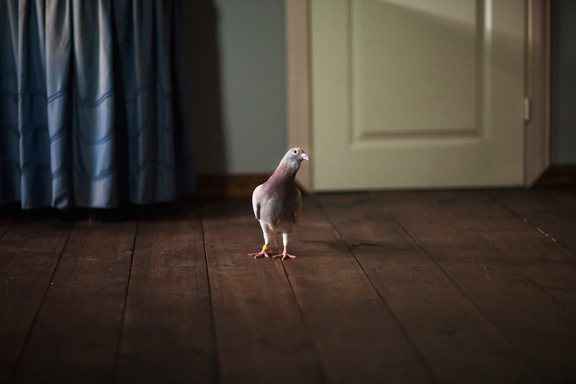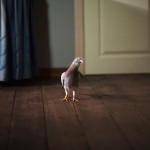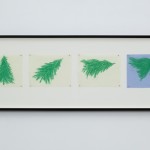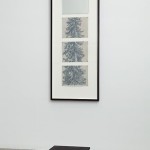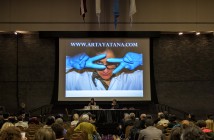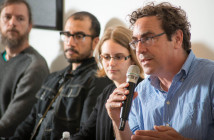When I'm walking down the street, my body makes assumptions that my consciousness doesn't even register. It respires—assuming that the environment around me will supply air that it can breathe. It presumes gravity when sending the electrical impulses to my muscles that allow me to move through space at will. When I raise my leg to take a step, my body takes for granted that my perception of my environment will remain stable enough for me to put it down again on solid ground. And even though I know about earthquakes and landmines, I put my foot down. Even though I know about tear gas and asbestos, I breathe.
These are only a few of an uncountable number of assumptions that my daily life requires me to make. I can blame these ones on my body, but there are others that I have to take responsibility for as conscious choices: I choose to believe when I get in a car or an airplane that it will not crash or explode. I choose to believe that I should go grocery shopping even though I could have an unexpected aneurysm and never cook the meal that I'm shopping for.
I am inspired by viewing the Eija-Liisa Ahtila retrospective show, Olentoja (Creatures) at the Davis Museum at Wellesley College (Sep 18 — Jan 5, 2014); by seeing Sini Anderson's THE PUNK SINGER (2013, Opening Band Films); by listening to Boston's Animal Hospital perform live on New Year's Eve as a part of Boston's 2014 First Night Celebrations; and by a February 2014 presentation at MIT by artist Jon Rubin (most famous for his Conflict Kitchen project) about some of his most recent work.
THE PUNK SINGER was not my favorite film in the world. But I love Sini Anderson's work as a poet; the film did a wonderful job of covering a certain moment in time; the music included was great; and then I can't easily think of another film that took the approach that this one did for weaving (or not weaving) narrative strings together.
Certain events were relayed differently by different characters. The main character, who was at the center of each of these events, contradicted herself whenever she discussed them. She contradicted herself in the present and her self in archival footage. Without apology. In some cases, she admitted to lying about her feelings, at other times she insisted on a right to more than one personal truth. And then at some point she says something that boils down to this: "Women don't have to tell stories the way that men tell stories. There's no guarantee that the structures that people follow in order to produce 'trustworthy accounts' are without bias, so you can choose to hear the story that I am telling you with all of the nuances that I intend and don't intend, or you can pull what you want from the material that I'm giving you and make up a story that works for you. It's your choice. I'm not promising there is no bias in the information that I present, but the information I'm sharing is yours to interpret however you want." These were not her exact words, but whatever it was that she said, it meant this.2 This was the first time3 I had ever seen someone directly address a camera and say that it was my problem as a viewer if I needed to assimilate conflicting information into something seamless. Not the filmmaker's or the editor's problem.
I am a long time fan of Boston's Animal Hospital Ensemble. I like the music itself, but I like the concept just as much. Animal Hospital Ensemble is a loose affiliation of (mostly Boston) musicians playing compositions by its leader Kevin Micka. The size of the group rises and falls depending on the context, needed instrumentation and people's availability. The compositions are learned quickly, rehearsed doggedly, and parts are cued live during performances using a projector aimed at the ceiling.
On New Year's Eve, my favorite time to see them, Animal Hospital includes about 25 guitarists and bassists, two to four drummers, and a handful of other instruments, sometimes played by people already playing guitars or drums.
When the musicians play, they perform in the round with the audience inside of the circle. At first I loved it because it felt like a ritual bath of music. A generous wash of sound to lose oneself in while letting go of the previous year's happinesses and sufferings.
This year, I noticed something different about the project. Though there is seating at the center of an Animal Hospital performance, you are not required to sit. I discovered that if you don't sit—if you stay mobile during the whole performance, moving into, out of, and around the circle and the room—the music changes constantly and radically in a way that it never could in a room with a stage at one end. If I wanted to—and I did—I could create my own compositions from the sound available at any given moment by shifting my location. I couldn't rearrange when a sound occurred, but I could decidedly put it in a different relationship to all of the other sounds that were happening simultaneously to it.
As the foremost expert on Eija-Liisa Athila's work, Mieke Bal,4 so precisely puts it in her discussion of The House, " . . . sound, by definition, moves: it is nothing but movement." By moving my body in space while Micka and company are moving the air with their amplified instruments, I am co-constituating the sound—my sound—with them. It's no different than dancing at a rock club to co-create a rock concert, but a structure which changes the framing of the audience-performer relationship gives me much more permission to do my own reframing of the situation than the current infrastructure of most rock clubs do.
Pittsburghan Jon Rubin's work is explicitly political. His most famous project, Conflict Kitchen, uses a fast food stand as a way of getting Americans to develop a more subtle view of the countries and cultures that we are bearing official hostility towards. By sharing food and small personal anecdotes on the food's wrappers, his work keeps otherness a little bit at bay, and each tidbit of sameness that he offers up whets appetites for more understanding.

In his Iranian iteration of the restaurant, an option existed to eat your meal with an Iranian friend of his via a local 'human avatar'. This person sits with you while you eat, wearing a pair of headphones, and participates in a real-time dialogue with you on behalf of Rubin's friend in Iran. Through a table mic, the Iranian friend hears what you say while you eat, and his responses are relayed to you verbatim by the Conflict Kitchen employee sitting across from you. Regardless of any discrepancy in accent, race, age or gender. Half of what makes this work is the humor of it. Rubin claims that he uses humor as a way to bypass the brain and get at "the gut"—something he feels all art with an agenda must do.
But it also works because of the destabilization of perspective and perception brought on by the means of communication. Everything about the interaction is so strange—so surreal—that the basic thing, the conversation itself, feels comparatively normal. And then of course if it feels normal to talk to an Iranian over your fast food, it starts to feel abnormal that he is your enemy. (Talking to you through a blonde girl with dreadlocks...)
Rather than dive directly into the content of the Olentoja (Creatures) show, I wanted to take you a little father back in time, to earlier in Ahtila's career.
If 6 Was 9 is from almost 20 years ago, but almost everything that characterizes Ahtila's work now was already in play then. The segments of the split screen (a triptych in installation form) compete with one another for your attention. You have to hold multiple perspectives simultaneously. The dialogue is disjointed. Some background sounds are amplified to a hyperrealistic level. The characters and their voices are not congruous. Affect, across the board, is flat. The relationship between the characters is unclear. Why you are seeing what you are seeing and hearing what you are hearing is never explained. The (urban) environment is given almost as much valence as the human characters on the screen. And the meaning of the title is never revealed.5
Some of these characteristics are not unique to Athila's work, and in fact many of these same strategies, and the inclusion of animal and plant perspectives alongside human ones, are found in the work of other Finnish video and installation artists as well.6 But Ahtila arguably does it with the most finesse and at the grandest scale. She also has a fixation on the mechanics of filmmaking and of dramaturgy that set her apart.
I won't give you a blow-by-blow description of the exhibit.7
I'll take you past the frolicking dogs and children in the lobby, give you a few minutes to wonder at the rippling glory of the horizontal portrait of the spruce, and then escort you right to my favorite part of the exhibit: a series of playful sketches called Anthropomorphic Exercises (on Film) Series A.
Though I love the sound and perspectival dynamics of all of the video works in the show, and believe they deserve the kind of accolades and attention (and sale prices) they've garnered, these little drawings are what captivated my attention most. The images look like the result of a children's book mating with an entry-level filmmaking handbook, but for me, they were the key to everything else in the show.
Athila admits that Horizontal was borne of perspectival problems she encountered when trying to shoot The Annunciation.8
Though it does many other things, one of the core things that The Annunciation does is refigure the flight scene from The House. The first flight (the one in The House) is magical—but requires a radical break from consensual reality to occur. The second flight (in The Annunciation) is mundane. Somehow, when looking for a miracle in the everyday, the extraordinary becomes ordinary and flight is stripped of its magic completely (though the fact that for a bird, flight is probably not magical at all is something to bear in mind here . . . )
But the magnificent portrait of the spruce paired with Anthropomorphic Exercises (On Film) Series A: Special Effect offers a third opportunity for flight, in a dimension that is a perfect hybrid environment of the magical and the mundane: the setting of an art exhibition.

Try viewing Horizontal horizontally (lay on your side on the bench) and suddenly you are flying! The tree looks right (though not proportionally) but your feet are off the ground.
Even when your feet are on the ground, and the tree is horizontal to you, you are still flying because it is visibly rooted, but you are relating to the tree as if one of you was floating in the air. Since you can see the tree's "foot" but not your own, you are the one flying. It's a special effect.

The surround-screen pieces, The House and The Annunciation, each require our bodies to complete the narrative meaningfully, but we do not need to move our bodies to fulfill our roles in relation to these pieces. We can sit physically still, and only move our attention. The Anthropomorphic Exercises, especially Point of View/With a Human,9 point towards a future interaction with Ahtila's work that will require physical engagement for it's full realization. Paying attention is not enough anymore. Now that we as viewers have been made to fly, we must be made to act.
In most interviews, Ahtila explains that her work is primarily concerned with one thing: recruiting collaborators to resolve large, ontological questions that she can't figure out completely by herself.
Her insistence on sharing the responsibility of solving problems and answering questions extends to animals, trees, actors, non-actors, and us. As tools for problem solving we are offered the opportunity to play with framing, the right to question the nature of time, the right to re-tool narrative so that it includes everything that we feel might be important—an ecosystem of thought and experience as well as or instead of a linear story. And the possibility of flight—of taking off from one place and landing in another, seeing the world differently while in the air, or simply being reminded of how much we take gravity for granted.
I have been watching video and reading about Ahtila on and off for over two months now. But I have felt very little while researching her. Sometimes there's some excitement to have intuitions that I had in my own interpretations of her work "confirmed" by her or someone else's interpretations. Sometimes I've felt frustration because the discourse around her work is dense but incredibly intriguing at the same time. It's hard to pick up, and hard to put down.
The first moment when real emotion breaks through all of this for me is at an odd point: while reading a footnote on page 79 of Meike Bal's Thinking in Film. It reads as follows:
See Elfving 2002 and 2009 for an analysis centered on the color red, specifically the red shirts worn by many of Ahtila's girl figures. Elfving connects the color to the Lacanian concept of the stain as a way of breaking out of the dichotomy of surface and depth, which in turn stands for the figure of the girl.
I have no idea why this footnote should bring tears to my eyes, but it somehow does. And they come again when I type it in here.
I don't always know what a response to something means. But I take note of emotional responses. They are my footnotes, my data, for something incomplete, something yet to be revealed.
These are highly political acts, destabilizing perspective, resisting narrative linearity, offering space and room for noise to unfold within signal and have potential meaning as well.10 Or as Ahtila puts it early on in The Annunciation, "For something to get started, one must merely begin and connect with a thing that isn't yet . . . How does one know what things are, unless they're already familiar?"
Cubism destabilized perspective, but the perspectival planes were different then. Time based media and contextual practices (often embedded in commerce in a way that three point perspective just never has been) add new cards to the deck being shuffled.
Pick a card. Any card.
- Eija-Liisa Ahtila, The Annunciation, 2010. 3 channel projected high definition installation with 5.1 channel audio, 33 minutes
- Eija-Liisa Ahtila, Anthropomorphic Exercises (On Film) Series A: Special Effect, Green pastel on Parisian paper, 2011. 21 1/2 x 65 3/8 x 1 7/8 in. (54.61 x 166.05 x 4.76 cm)
- Eija-Liisa Ahtila, Anthropomorphic Exercises (On Film) Series A: Point-of-View / With a Human; Green pastel on Parisian paper, mirror; 2011 54 1/4 x 22 3/4 x 1 7/8 in. (137.8 x 57.79 x 4.76 cm)
[1] Though I feel that the textual description of the film that can be found via the link here should make it abundantly clear why it is so hard to resist Finland's unique charms . . .
[2] To me.
[3] Actually, after I wrote this, I re-viewed 98.9% of Peter Watkin's 6.5 hour documentary about the Paris Commune, LA COMMUNE (2000, La Septe/Arte 13 Production) and realized that this was not the first time—his characters regularly say (or often scream) much the same thing, while looking right into the camera.
[4] Bal, Mieke, Thinking in Film, p.83 (Bloomsbury Academic, 2013)
[5] Could it be this?
[6] Including much of the work of Maria Duncker, mentioned in the first footnote of this article.
[7] Big Red & Shiny has already done a review of this show here: http://www.bigredandshiny.com/cgi-bin/BRS.cgi?article=2013-08-27-051154528817584546, so read that if you'd like a more detailed tour. And another perspective.
[8] In this interview, and in discussion of the piece in this video, at approximately 11:05.
[9] See discussion of this piece at the end of this interview.
[10] It took all of my strength to keep myself from expanding this essay to include a section on glitch art. This is long and convoluted enough as is, but glitch art has a significant and political place in this discussion. As does Bryan Gysin. whom I think of as the original glitch artist. But I guess I'll save that story for another piece of writing.

